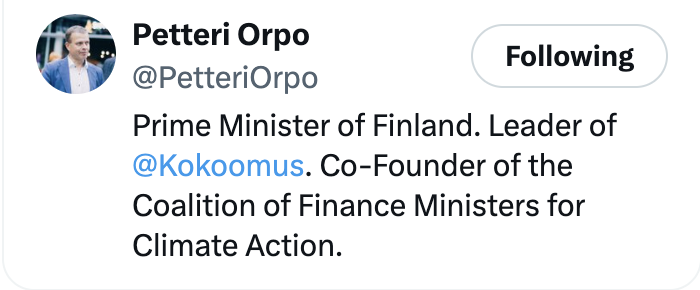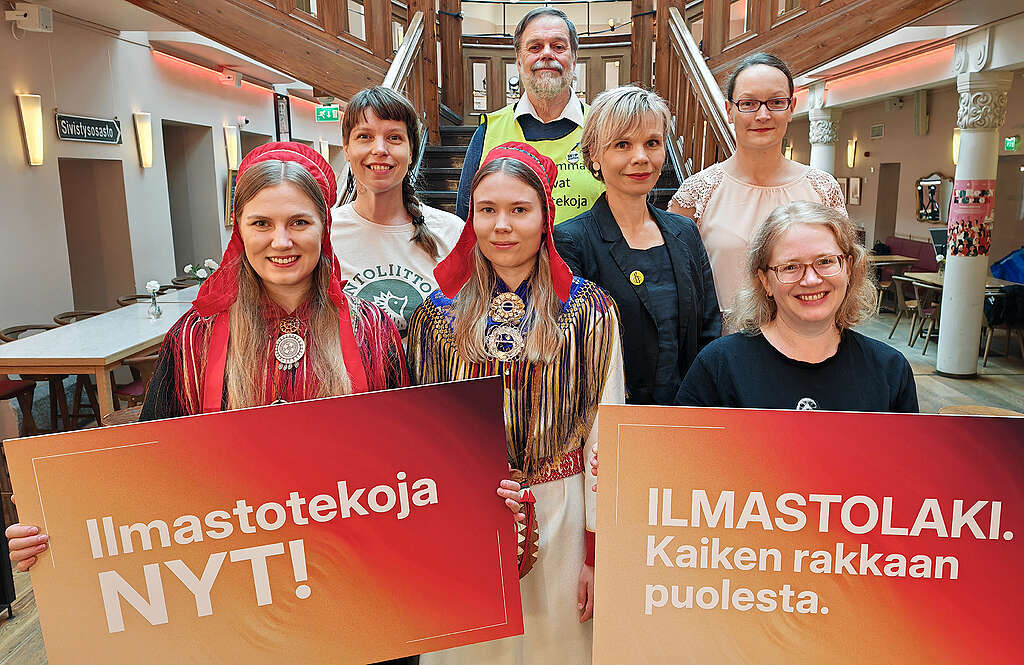Finnish Sami Youth together with Finnish environmental and human rights organisations are taking their state to court. Finland has committed to become climate neutral by 2035. This, along with other science-based targets, are set in Finland’s climate law. But now Orpo’s government is failing to respect the law.
Here are 10 things you should know about the case filed by Greenpeace Norden (Nordic) and five other NGOs in August 2024. The appeal has been coordinated by the Finnish Association for Nature Conservation.
1. Finland’s net zero 2035 target is science-based and people powered
Finland’s target of becoming climate neutral by 2035 is one of the strongest among industrialized countries. Not perfect, for sure. But it was recommended by scientists (The Finnish Climate Change Panel) in the aftermath of the IPCC 1.5 degrees report, called for by citizens, adopted with a broad majority across political parties, and is supported by Finnish business and trade unions alike.
It’s all people-powered. Finland’s climate law was originally initiated by a determined NGO campaign (The Big Ask) and came into force in 2015. Then later the Act was strengthened, including with net zero 2035 and other new emission reduction targets, under Sanna Marin’s government, following the biggest climate uprisings in Finland’s history in 2018–2019. (Read more here.)

2. It’s less dodgy than you might think
Finland will reach climate neutrality by 2035 if emissions are cut by 70 % and removals are increased to a level they were historically, on average, since 1990. Beyond 2035, Finland must become climate negative, meaning removals become bigger than emissions.
Sounds dodgy? Avoiding emission cuts by relying on removals? No, not really. It just means that Finland will have to deliver both on emissions and removals. Fossil emissions must keep declining steadily towards near zero, but in parallel, Finland will also have to strengthen its natural carbon sinks and stocks and reduce agriculture emissions (and gradually implement technological sinks, should they materialise). For a country like Finland, with a big forest industry, high use of biomass for energy and lots of peatlands in commercial use, this is actually the hard part.
International offsets have not played part in the target-setting or implementation plans.
3. We’re cool with wind, but in trouble with cars, peatlands and forestry
Finland has taken action – on some fronts. Our energy sector emissions have already declined by nearly 60 % since their peak in 2003. Fossil fuel use is down to 30% of total energy consumption, and 8 % of electricity. In a couple of years, wind is becoming the biggest source of power, and by 2030, wind is set to produce half of Finland’s electricity, while solar could contribute 5–10 %.
But then there’s the rest. Transport emissions aren’t declining as fast as they should, agricultural emissions have not declined at all, and then there’s the whole land use sector, where the main problem lies.
Despite warnings by scientists, wood harvesting levels have been allowed to grow too high, clearcuts still dominate in peatland forests, biomass use for energy exceeds sustainability, measures to reduce emissions from peat fields remain undone and even some deforestation still occurs for agriculture purposes. At the same time forest growth has slowed. As a result, in 2021 for the first time, Finland’s land use sector was revealed to be a net emission source. This means we’re really badly off track from our binding sink targets under the EU LULUCF regulation.
4. Forests and land really matter
In fighting global heating, phasing out fossil fuels is a priority. But alone that’s not enough. As the IPCC has underlined, we’ll also have to protect and restore natural ecosystems to remove carbon and build resilience, and transition to climate smart food systems.
Finland’s carbon sink did not collapse on its own. Scientists have been warning for years that if logging levels are increased, the ability of forests to cool the climate will decrease and biodiversity goals won’t be met. And so it happened.
The results are mindblowing: Finland’s total emissions are now -43 % below 1990 levels, but this excludes the land sector (so-called LULUCF). When all sectors are included Finland’s net emissions haven’t practically declined at all since 1990! (1)
The situation won’t change unless policies and economic incentives change.
5. Technological sinks? Won’t fix the current problem.
Instead of restoring Finland’s net sink with tools available right now, the Finnish government and forest industry would rather talk about so-called technological sinks (technology-based carbon removal) that might produce removals in the future, by capturing and storing emissions from facilities burning biomass. And ok sure, there is technical potential, as Finland’s biogenic CO2 emissions are already higher than its fossil CO2 emissions! But then we’re talking about measures that are multiple times more costly (€120–240/tCO2), and won’t deliver in the near future anyway. Meanwhile, effective measures to restore the net sink in the land sector, with only a fraction of that cost, remain undone right now, for no good reason.
So again, delaying action is not an option.
6. Time to walk the talk on economics
So there’s a problem. But Mr Petteri Orpo should know what to do. For he is not only Finland’s Prime Minister, but also the Co-Founder of the Coalition of Finance Ministers for Climate Action, as he proudly mentions in his Twitter/X profile. This is a coalition of over 90 countries, aiming to wield fiscal and economic instruments to achieve climate goals.

Now it’s time for PM Orpo himself to walk the talk, and follow the coalition’s “Helsinki Principles”, to align Finland’s economic tools with the Paris Agreement.
How? Well, Finland has been getting advice on this from the IMF, the OECD and the Economic Policy Council (EPC), who’ve all said in their economic reviews that more is needed to achieve Finland’s climate targets, particularly in the land-use sector. They all point to economic tools and to the principle of making polluters pay. In the case of sinks, this means, for example, forest industry having to pay for the loss of carbon sinks they cause, rather than taxpayers subsidising the forest sector.
7. The way out? Listen to science and follow the law.
For over two years now, Finnish scientists have been pointing to different solutions to bridge the gap between targets and action, but decisions have not been made. On the contrary, Orpo’s government has even canceled some earlier agreed climate policies. There are no signs of the government taking the situation seriously, or aiming to respect the relevant provisions of the Climate Act, which is why NGOs decided to take legal action.
An administrative appeal was filed to the Supreme Administrative Court in August 2024, with a simple demand: respect the law. The government must decide on sufficient additional measures and revise essential policy plans to meet its climate targets and other obligations laid out in the Climate Act and EU climate legislation, the Constitution of Finland and the European Convention on Human Rights.

8. We’re defending our national treasures and rights
Finland is an Arctic country, the northernmost country in the European Union. Having snow, ice and healthy nature is essential to our wellbeing and identity – forming a key part of who we are as Finns. Now the Arctic region is warming much faster than other parts of the world, putting everything we love at risk. For the Sàmi, whose homeland is in the northernmost part of Lapland, this is particularly the case.
Finland’s Climate Act recognises the special rights and vulnerabilities of the Sámi, the only designated indigenous people in the European Union. By violating its own climate law, Finland is also violating the rights of the Sámi, which is why the Finnish Sámi Youth joined the coalition that’s taking legal action.
9. We’re grateful for the Swiss seniors who paved the way!
The legal case has been filed by the Finnish Association for Nature Conservation, Greenpeace Norden (Nordic), Amnesty International Finland, Grandparents for Climate, the Finnish Nature League and the Finnish Sámi Youth.
Primarily, it builds on a previous court ruling by Finland’s Supreme Administrative Court, which put the government on notice. But it’s also the first national case to build on the groundbreaking climate ruling by the European Court on Human Rights in the case of KlimaSeniorinnen v Switzerland, which is expected to inspire a new wave of climate justice litigation in the member states of the Council of Europe. (Yay! We got there first!)
10. This drop in the ocean matters
Finland’s climate law isn’t perfect. The targets could and should be stronger and fairer still, and cover consumption emissions too. And that will come, as the climate law does require the targets to be monitored for scientific and legal adequacy. But now we want to ensure the current targets are swiftly implemented.
Finland’s emissions are a drop in the ocean, but every drop counts. Finland is a country ranking high in wealth, technological skills, capability, innovation and responsibility. It enjoys broad public support for strong climate action, and is home to Europe’s largest climate business network CLC – who also stands behind Finland’s climate neutrality 2035 goal. If countries like Finland don’t even try delivering their part in full, and instead give up when the first hurdles come, why should anyone else?
We want Finland to succeed!
(1) Preliminary data for 2023 shows some decline in Finland’s net emissions, compared to 1990, but this isn’t changing the big picture, as wood harvests are set to grow again this year and next year, turning the curve back up.
